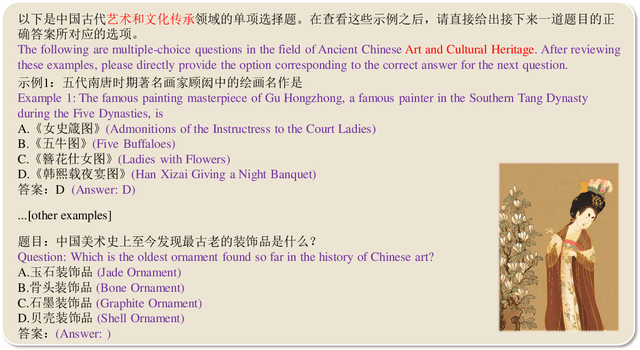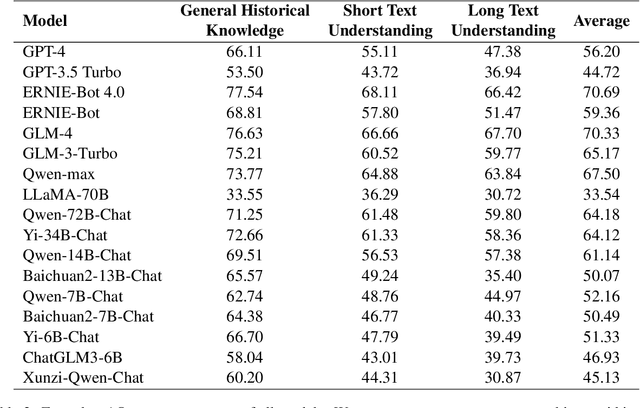Xinru Wei
AC-EVAL: Evaluating Ancient Chinese Language Understanding in Large Language Models
Mar 11, 2024



Abstract:Given the importance of ancient Chinese in capturing the essence of rich historical and cultural heritage, the rapid advancements in Large Language Models (LLMs) necessitate benchmarks that can effectively evaluate their understanding of ancient contexts. To meet this need, we present AC-EVAL, an innovative benchmark designed to assess the advanced knowledge and reasoning capabilities of LLMs within the context of ancient Chinese. AC-EVAL is structured across three levels of difficulty reflecting different facets of language comprehension: general historical knowledge, short text understanding, and long text comprehension. The benchmark comprises 13 tasks, spanning historical facts, geography, social customs, art, philosophy, classical poetry and prose, providing a comprehensive assessment framework. Our extensive evaluation of top-performing LLMs, tailored for both English and Chinese, reveals a substantial potential for enhancing ancient text comprehension. By highlighting the strengths and weaknesses of LLMs, AC-EVAL aims to promote their development and application forward in the realms of ancient Chinese language education and scholarly research. The AC-EVAL data and evaluation code are available at https://github.com/yuting-wei/AC-EVAL.
Exploring the relationship between response time sequence in scale answering process and severity of insomnia: a machine learning approach
Oct 13, 2023Abstract:Objectives: The study aims to investigate the relationship between insomnia and response time. Additionally, it aims to develop a machine learning model to predict the presence of insomnia in participants using response time data. Methods: A mobile application was designed to administer scale tests and collect response time data from 2729 participants. The relationship between symptom severity and response time was explored, and a machine learning model was developed to predict the presence of insomnia. Results: The result revealed a statistically significant difference (p<.001) in the total response time between participants with or without insomnia symptoms. A correlation was observed between the severity of specific insomnia aspects and response times at the individual questions level. The machine learning model demonstrated a high predictive accuracy of 0.743 in predicting insomnia symptoms based on response time data. Conclusions: These findings highlight the potential utility of response time data to evaluate cognitive and psychological measures, demonstrating the effectiveness of using response time as a diagnostic tool in the assessment of insomnia.
Attention-Based Acoustic Feature Fusion Network for Depression Detection
Aug 24, 2023Abstract:Depression, a common mental disorder, significantly influences individuals and imposes considerable societal impacts. The complexity and heterogeneity of the disorder necessitate prompt and effective detection, which nonetheless, poses a difficult challenge. This situation highlights an urgent requirement for improved detection methods. Exploiting auditory data through advanced machine learning paradigms presents promising research directions. Yet, existing techniques mainly rely on single-dimensional feature models, potentially neglecting the abundance of information hidden in various speech characteristics. To rectify this, we present the novel Attention-Based Acoustic Feature Fusion Network (ABAFnet) for depression detection. ABAFnet combines four different acoustic features into a comprehensive deep learning model, thereby effectively integrating and blending multi-tiered features. We present a novel weight adjustment module for late fusion that boosts performance by efficaciously synthesizing these features. The effectiveness of our approach is confirmed via extensive validation on two clinical speech databases, CNRAC and CS-NRAC, thereby outperforming previous methods in depression detection and subtype classification. Further in-depth analysis confirms the key role of each feature and highlights the importance of MFCCrelated features in speech-based depression detection.
 Add to Chrome
Add to Chrome Add to Firefox
Add to Firefox Add to Edge
Add to Edge